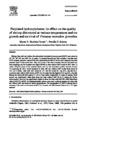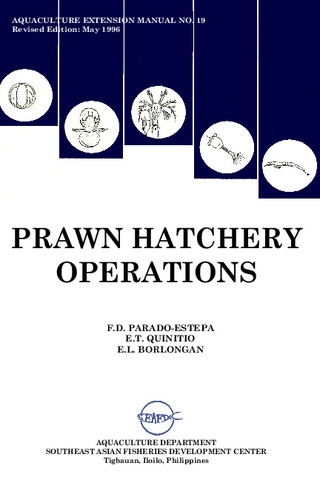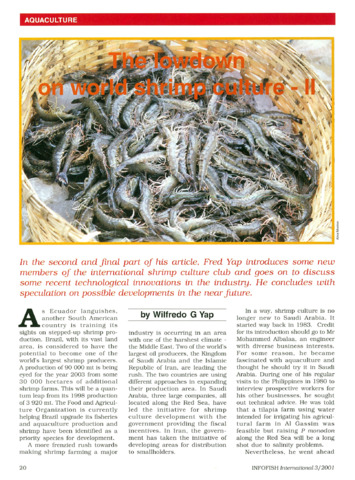Butylated hydroxytoluene: its effect on the quality of shrimp diet stored at various temperatures and on growth and survival of Penaeus monodon juveniles
- Global styles
- MLA
- Vancouver
- Elsevier - Harvard
- APA
- Help

View/
Date
1999Page views
1,763ASFA keyword
AGROVOC keyword
Taxonomic term
Metadata
Show full item record
Share
Abstract
Shrimp diets with and without the antioxidant, butylated hydroxytoluene (BHT) were stored at 10°, 20°, 28°–30°, and 40°C for 10 weeks. To monitor lipolysis and lipid oxidation, free fatty acid (FFA) content, peroxide values (PVs), and malonaldehyde (MAL) levels were measured from the extracted lipids of the stored diets. Fatty acid levels of the diets increased between the initial and final samplings and the increase was higher (8.4%) in diets without BHT stored at 40°C after 10 weeks. Peroxide values of the extracted lipids were low and fluctuated monthly between 2.2 and 7.4 mmol/kg fat. MAL levels increased in diets with and without BHT except those stored at 10°C for 4 weeks. Diets with BHT stored at 10°C had the lowest (8.7 mg MAL/kg fat) MAL levels and diets without BHT stored at 40°C for 10 weeks had the highest (16.9 mg MAL/kg fat). Shrimp fed diets with BHT gained 5.7–6.4× their initial weight after 10 weeks of rearing. Their growth was significantly better than those fed diets without BHT (4–6×) during the 60-day culture period. Survival was significantly higher in those fed diets with BHT (87–88%) than those without BHT (75–85%). No hepatopancreatic lesions were seen in shrimp samples fed diets with and without BHT and stored at various temperatures. The incorporation of BHT in shrimp feed is necessary if the feed is to be stored at 40°C for 10 weeks.
Suggested Citation
Bautista-Teruel, M. N., & Subosa, P. F. (1999). Butylated hydroxytoluene: its effect on the quality of shrimp diet stored at various temperatures and on growth and survival of Penaeus monodon juveniles. Aquaculture , 179(1-4), 403-414. https://doi.org/10.1016/S0044-8486(99)00174-X
Type
ArticleISSN
0044-8486Collections
- Journal Articles [1258]
Related items
Showing items related by title, author, creator and subject.
-
An overview of the nutrition, feed and feeding techniques of prawn penaeid/shrimps
Piedad-Pascual, Felicitas (Philippine Council for Aquatic and Marine Research and Development, 1989)This paper echoes what transpired during the first International Conference of Penaeid Prawns/Shrimps held in Iloilo City in December 4-7, 1984, particularly on the Nutrition nd Feed Development. Around 25 papers were ... -
Series: Aquaculture extension manual; No. 19
Prawn hatchery operations
Parado-Estepa, Fe D.; Quinitio, Emilia T. ; Borlongan, Emeterio L. (Aquaculture Department, Southeast Asian Fisheries Development Center, 1996-05)
The manual, an updated version of the 1984 SEAFDEC/AQD manual, presents the underlying principles and step-by-step instructions of prawn larval and post-larval rearing. The techniques described are not only applicable to ...
; Borlongan, Emeterio L. (Aquaculture Department, Southeast Asian Fisheries Development Center, 1996-05)
The manual, an updated version of the 1984 SEAFDEC/AQD manual, presents the underlying principles and step-by-step instructions of prawn larval and post-larval rearing. The techniques described are not only applicable to ... -
The lowdown on world shrimp culture - II
Yap, Wilfredo G. (INFOFISH, 2001)This paper introduces some new members of the international shrimp culture club and goes on to discuss some recent technological innovations in the industry, particularly the polyculture of tilapia (mainly Oreochromis ...





